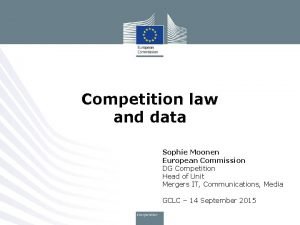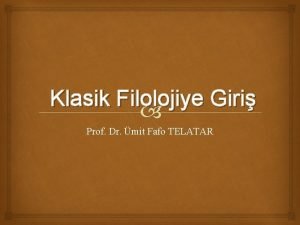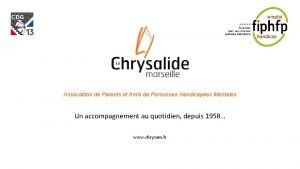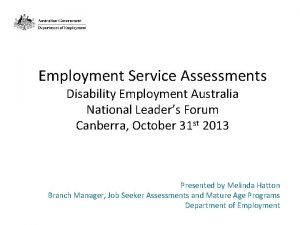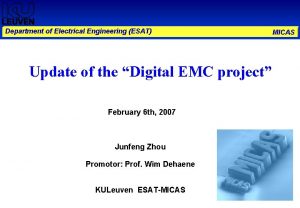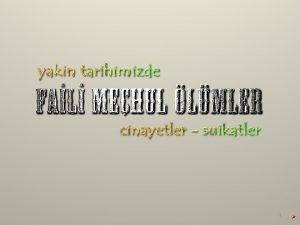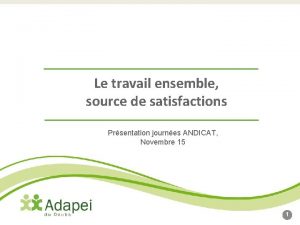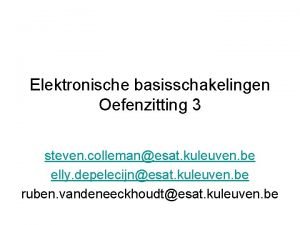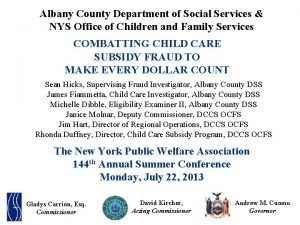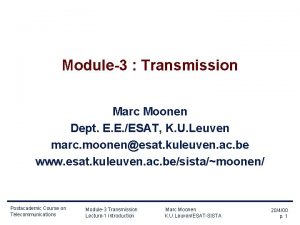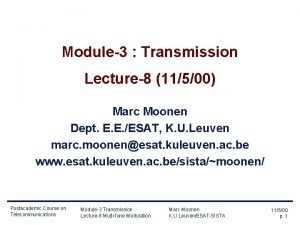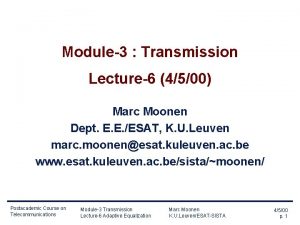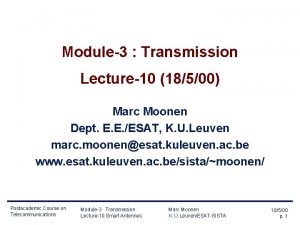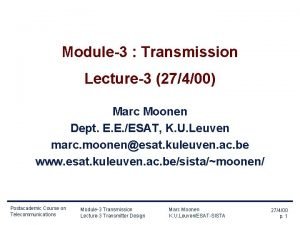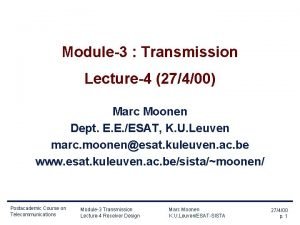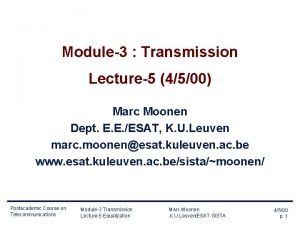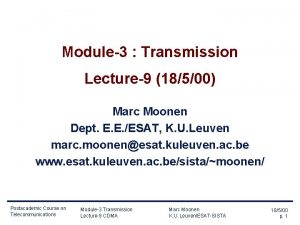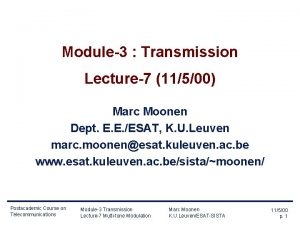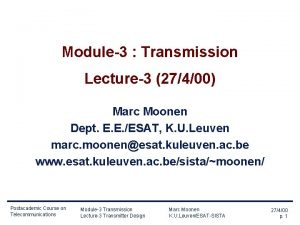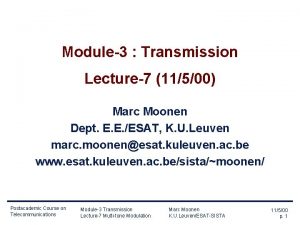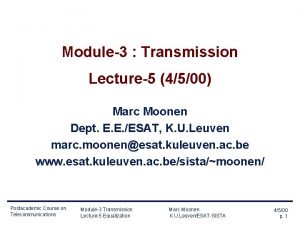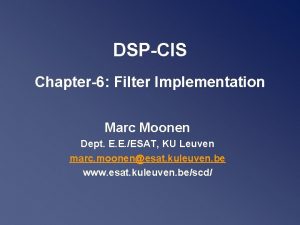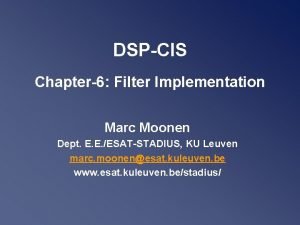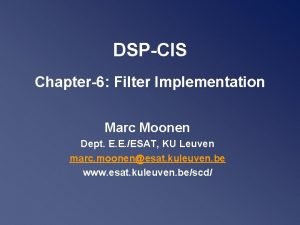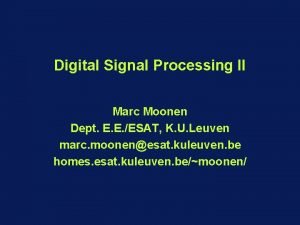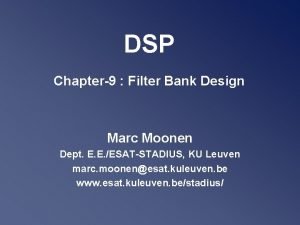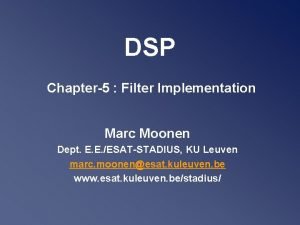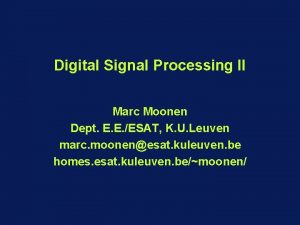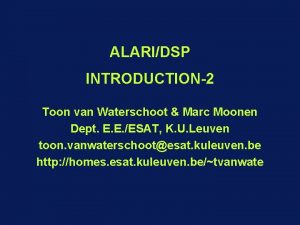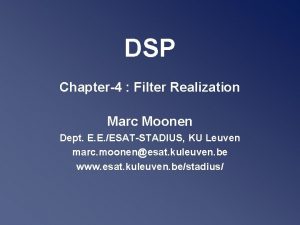Module3 Transmission Marc Moonen Dept E E ESAT








































- Slides: 40

Module-3 : Transmission Marc Moonen Dept. E. E. /ESAT, K. U. Leuven marc. moonen@esat. kuleuven. ac. be www. esat. kuleuven. ac. be/sista/~moonen/ Postacademic Course on Telecommunications Module-3 Transmission Lecture-1 Introduction Marc Moonen K. U. Leuven/ESAT-SISTA 20/4/00 p. 1

Module-3 : Transmission • • Module 1: Introduction to Telecommunications & Networks Module 2: Telecommunication Networks and Technologies Module 3: Transmission Techniques Module 4: Transmission of Sound, Video & Data Postacademic Course on Telecommunications Module-3 Transmission Lecture-1 Introduction Marc Moonen K. U. Leuven-ESAT/SISTA 20/4/00 p. 2

Aims/Scope • Basic Digital Communication principles modulation/demodulation, detection (for the regraders/sidegraders) • New/Advanced Topics CDMA, multicarrier modulation, smart antennas (for the regraders/upgraders) • Mostly `bird’s-eye view’ skip mathematical details (if possible) selection of topics (non-exhaustive) Postacademic Course on Telecommunications Module-3 Transmission Lecture-1 Introduction Marc Moonen K. U. Leuven-ESAT/SISTA 20/4/00 p. 3

New/Advanced Topics? • Analog & 1 G Digital Communication Systems: communication over fairly `simple’ (e. g. AWGN) channels emphasis on modulation/demodulation/timing/etc. . . circuitry • Present Day/Future Communication Systems = box full of mathematics & signal processing for communication over highly bandwidth constrained channels, fading channels, etc. . . Postacademic Course on Telecommunications Module-3 Transmission Lecture-1 Introduction Marc Moonen K. U. Leuven-ESAT/SISTA 20/4/00 p. 4

New/Advanced Topics ? • Example: Telephone Line Modems voice-band modems : up to 56 kbits/sec in 0. . 4 k. Hz band ADSL modems : up to 8 Mbits/sec in 30 k. Hz… 1 MHz band VDSL modems : up to 52 Mbits/sec in … 10 MHz band x. DSL communication impairments: channel attenuation/distortion, echo, cross-talk, RFI, . . . see Lecture-7/8 Postacademic Course on Telecommunications Module-3 Transmission Lecture-1 Introduction Marc Moonen K. U. Leuven-ESAT/SISTA 20/4/00 p. 5

New/Advanced Topics? • Example : Wireless Communications Typical spectral efficiency : . . . 1 bits/sec/Hz MIMO-transmission (`smart antennas’ & co): example : V-BLAST (Lucent Techn. 1998) … 40 bits/sec/Hz exploits a `rich scattering environment’ see Lecture-2, Lecture-10 Postacademic Course on Telecommunications Module-3 Transmission Lecture-1 Introduction Marc Moonen K. U. Leuven-ESAT/SISTA 20/4/00 p. 6

New/Advanced Topics? Enabling Technology is • Signal Processing 1 G-SP: analog filters 2 G-SP: digital filters, FFT’s, etc. 3 G-SP: full of mathematics, linear algebra, statistics, etc. . . • VLSI • etc. . . Postacademic Course on Telecommunications Module-3 Transmission Lecture-1 Introduction Marc Moonen K. U. Leuven-ESAT/SISTA 20/4/00 p. 7

Overview (I) • 20/4/2000 Lecture-1 : General Intro Lecture-2 : Limits of Communication • 27/4/2000 Lecture-3 : Transmitter Design/Modulation Lecture-4 : Receiver Design/Detection • 4/5/2000 Lecture-5 : Channel Equalization Lecture-6 : Adaptive Equalization Postacademic Course on Telecommunications Module-3 Transmission Lecture-1 Introduction Marc Moonen K. U. Leuven-ESAT/SISTA 20/4/00 p. 8

Overview (II) • 11/5/2000 Lecture-7 : Multicarrier Modulation (I) Lecture-8 : Multicarrier Modulation (II) • 18/5/2000 Lecture-9 : Multiple Access/CDMA Lecture-10: Smart Antennas/MIMO-transmission Postacademic Course on Telecommunications Module-3 Transmission Lecture-1 Introduction Marc Moonen K. U. Leuven-ESAT/SISTA 20/4/00 p. 9

Assignments & Exam • Assignments Pen & paper exercises Self-study material • Exam 25/5/2000 • WWW-site : telecom. europace. be Postacademic Course on Telecommunications Module-3 Transmission Lecture-1 Introduction Marc Moonen K. U. Leuven-ESAT/SISTA 20/4/00 p. 10

Prerequisites • • Module-1 - M. Goossens : Yes (? ) Module-2 - P. De. Meester : No Digital Communications Background : No (? ) Mathematics Background : Yes statistics, linear algebra -> see assignments • Signal Processing Background : Yes digital filters, transforms, stochastic processes -> see assignments Postacademic Course on Telecommunications Module-3 Transmission Lecture-1 Introduction Marc Moonen K. U. Leuven-ESAT/SISTA 20/4/00 p. 11

Literature • E. A. Lee & D. G. Messerschmitt `Digital Communication’ (Kluwer AP 1994) • J. G. Proakis `Digital Communications’ (Mc. Graw Hill 1989) • B. Sklar `Digital Communications’ (Prentice-Hall 1988) • S. Haykin `Communication Systems’ (Wiley 1994) • H. Meyr, M. Moeneclaey & S. Fechte `Digital Communication Receivers’ (Wiley 1998) • etc. . . Postacademic Course on Telecommunications Module-3 Transmission Lecture-1 Introduction Marc Moonen K. U. Leuven-ESAT/SISTA 20/4/00 p. 12

Acknowledgement Many of the slides/text/figures/graphs are adopted from the handouts of Module T 2 `Digital Communication Principles’ M. Engels, M. Moeneclaey, G. Van Der Plas 1998 Postgraduate Course on Telecommunications Special thanks to Prof. Marc Moeneclaey Postacademic Course on Telecommunications Module-3 Transmission Lecture-1 Introduction Marc Moonen K. U. Leuven-ESAT/SISTA 20/4/00 p. 13

Lecture-1 : General Introduction • Analog vs. Digital Communication • Digital Communication Systems Description Transmitter Channel Receiver • Preview Lectures 2 ->10 Postacademic Course on Telecommunications Module-3 Transmission Lecture-1 Introduction Marc Moonen K. U. Leuven-ESAT/SISTA 20/4/00 p. 14

Analog vs. Digital Communication (I) Analog Communication: • Transmission of signals that are inherently analog (speech, video, etc. . ) • Baseband or passband (AM, FM, . . ) • Bandwidth = signal bandwidth Example: speech signal 0. . 4 k. Hz -> BW=4 k. Hz • Received signal subject to channel impairments, transmitter/receiver impairments, etc. . Postacademic Course on Telecommunications Module-3 Transmission Lecture-1 Introduction Marc Moonen K. U. Leuven-ESAT/SISTA 20/4/00 p. 15

Analog vs. Digital Communication (II) Digital Communication: • Transmission of signals that are inherently digital (`data’) or analog (speech, video, etc. . ) • Analog signals are converted into digital signals by sampling & quantization (A-to-D conversion) Example : =PCM (pulse code modulation) - speech 0… 4 k. Hz - sampled at 8 k. Hz (cfr. Nyquist criterion), - each sample converted into 8 bits number-> 64 kbits/sec Postacademic Course on Telecommunications Module-3 Transmission Lecture-1 Introduction Marc Moonen K. U. Leuven-ESAT/SISTA 20/4/00 p. 16

Analog vs. Digital Communication (III) Digital Communication • What? A principle feature of a digital communication system is that during a finite interval of time, it sends a waveform from a finite set of possible waveforms. The objective of the receiver is not to reproduce the transmitted waveform, but (only) to determine which of the possible waveforms has been sent. Postacademic Course on Telecommunications Module-3 Transmission Lecture-1 Introduction Marc Moonen K. U. Leuven-ESAT/SISTA 20/4/00 p. 17

Analog vs. Digital Communication (IV) Digital Communication Key Features: • source coding/compression: Example: speech signal 64 kbits/sec-> 11 kbits/sec… 4 kbits/sec (through `signal modeling’) • channel coding/error correction see also Module-4 • increased spectral efficiency through coding, signal processing, etc. Example: v. 34 voice-band modem 33. 6 kbits/sec in 4 k. Hz voice-band (=8 bits/sec/Hz) Postacademic Course on Telecommunications Module-3 Transmission Lecture-1 Introduction Marc Moonen K. U. Leuven-ESAT/SISTA 20/4/00 p. 18

Digital Communication System (I) • Block Diagram digital information continuous-time channel s(t) Tx digital information r(t) channel Transmitter with D-to-A Rx Receiver with A-to-D • Digital Information is digital signal (data) or `sampled+quantized’ analog signal (speech, . . ) Postacademic Course on Telecommunications Module-3 Transmission Lecture-1 Introduction Marc Moonen K. U. Leuven-ESAT/SISTA 20/4/00 p. 19

Digital Communication System (II) Transmitter • converts bit sequence into waveform s(t) (=`modulation’) • bits are grouped into `symbols’ (n bits per symbol, hence M=2^n different symbols) (=`symbol alphabet’, `constellation’) • each symbol corresponds to a different waveform segment • symbol rate = # transmitted symbols/sec = Rs (`Baud rate’, after Baudot, French telegraph engineer) Postacademic Course on Telecommunications Module-3 Transmission Lecture-1 Introduction Marc Moonen K. U. Leuven-ESAT/SISTA 20/4/00 p. 20

Digital Communication System (III) Channel • physical medium : twisted pair, coax, optical fiber, radio • channel impairments : noise, attenuation/distortion, cross-talk, interference, etc… Postacademic Course on Telecommunications Module-3 Transmission Lecture-1 Introduction Marc Moonen K. U. Leuven-ESAT/SISTA 20/4/00 p. 21

Digital Communication System (IV) Receiver • Converts received signal r(t) into bit sequence (=`demodulation/detection’) • Receiver performance : Bit Error Probability (BEP) or Bit Error Rate (BER) BER = (#bit errors) / (#transmitted bits) example : voice : BER <1 E-3 data : BER <1 E-10 Postacademic Course on Telecommunications Module-3 Transmission Lecture-1 Introduction Marc Moonen K. U. Leuven-ESAT/SISTA 20/4/00 p. 22

Transmitter (I) • Transmitted bits are grouped into symbols (n bits per symbol, hence M=2^n symbols) • Transmitted symbols are • Transmitted signal is where p(t) is transmit pulse, and is symbol energy ( and p(t) are energy-normalized), Ts is symbol period Postacademic Course on Telecommunications Module-3 Transmission Lecture-1 Introduction Marc Moonen K. U. Leuven-ESAT/SISTA 20/4/00 p. 23

Transmitter (II) • Transmitted signal is em p ha s is on thi s • Linear modulation (e. g. PAM, QAM, PSK) all signal segments are proportional to the same pulse p(t) se ea ss see Lecture-3 for pulse design • Non-linear modulation (e. g. FSK) Postacademic Course on Telecommunications Module-3 Transmission Lecture-1 Introduction Marc Moonen K. U. Leuven-ESAT/SISTA ign me nts 20/4/00 p. 24

Transmitter (III) • Constellations for linear modulation (=`symbol alphabet’) PAM PSK pulse amplitude modulation QAM phase-shift keying I I I R 4 -PAM (2 bits) quadrature amplitude modulation R R 8 -PSK (3 bits) 16 -QAM (4 bits) ps: complex constellations for passband transmission (see Lecture-3) Postacademic Course on Telecommunications Module-3 Transmission Lecture-1 Introduction Marc Moonen K. U. Leuven-ESAT/SISTA 20/4/00 p. 25

Channel (I) Channel impairments: • • • attenuation/distortion (linear/non-linear) noise (linear/non-linear) cross-talk (1 or many) echo (e. g. hybrid impedance mismatch) RFI (e. g. amateur radio) Postacademic Course on Telecommunications Module-3 Transmission Lecture-1 Introduction Marc Moonen K. U. Leuven-ESAT/SISTA 20/4/00 p. 26

Channel (II) • Mostly simple linear channel models • Example: AWGN-channel (additive white Gaussian noise channel) r(t)=Ho. s(t)+n(t) s(t) Ho + channel n(t) is zero-mean Gaussian process with power spectrum No/2 for |f|<B (B=bandwidth) (example: satellite communication channel) Postacademic Course on Telecommunications Module-3 Transmission Lecture-1 Introduction Marc Moonen K. U. Leuven-ESAT/SISTA 20/4/00 p. 27

Channel (III) • PS: Gaussian noise model justified through central limit theorem (ex: 1 cross-talker is non-Gaussian, 30 cross-talkers approx. Gaussian) • PS: `White’ actually means `white within useful bandwidth’ i. o. truly `white’ (->infinite power hence ill-defined) • Example: frequency-selective channel R(f)=H(f). S(f)+N(f) s(t) H(f) channel + n(t) frequency-dependent channel attenuation/phase distortion (example: twisted pair, coax) Postacademic Course on Telecommunications Module-3 Transmission Lecture-1 Introduction Marc Moonen K. U. Leuven-ESAT/SISTA 20/4/00 p. 28

Receiver (I) • Receiver retrieves transmitted symbols from received signal r(t) • This leads to an optimization problem Example: minimum distance receiver where p’(t) is transmit pulse p(t), modified by channel Postacademic Course on Telecommunications Module-3 Transmission Lecture-1 Introduction Marc Moonen K. U. Leuven-ESAT/SISTA 20/4/00 p. 29

Receiver (II) • For AWGN channels (<->frequency-selective channels), a receiver may consist of : Module-3 Transmission Lecture-1 Introduction Marc Moonen K. U. Leuven-ESAT/SISTA se e Postacademic Course on Telecommunications le 3 e ct ur • Timing instant for symbol-rate sampling is crucial, hence synchronization scheme needed ! 4 - (a front-end `(whitened) matched filter’, WMF) - a symbol-rate sampler (i. e. 1 sample/symbol interval) - a (memory-less) decision device that decides on the nearest symbol in the symbol alphabet r(t) 1/Ts WMF 20/4/00 p. 30

Receiver (III) • For frequency-selective channels, the receiver may consist of - WMF + symbol-rate sampling front-end, or - anti-alias filtering + Nyquist-rate sampling front-end followed by more complicated processing: - Maximum-likelihood sequence estimation (e. g. Viterbi algorithms) - Equalization + decision device -… • See Lecture 4 -5 Postacademic Course on Telecommunications Module-3 Transmission Lecture-1 Introduction Marc Moonen K. U. Leuven-ESAT/SISTA 20/4/00 p. 31

Preview Lectures 2 ->10 Lecture-2 : Limits of Communication • Given a communication channel, an amount of transmit power and transmit bandwidth, what is the maximum achievable transmission bitrate (bits/sec), for which the bit-error-rate is sufficiently (infinitely) small ? • Shannon theory (1948) • Recent topic: MIMO-transmission (e. g. V-BLAST, cfr. supra) Postacademic Course on Telecommunications Module-3 Transmission Lecture-1 Introduction Marc Moonen K. U. Leuven-ESAT/SISTA 20/4/00 p. 32

Preview Lectures 2 ->10 Lecture-3 : Transmitter Design/Modulation • Baseband vs passband modulation • Constellations for linear modulation • Transmit pulse p(t) design: `(root) raised cosine pulses’ • Simple receiver structures, eye diagrams, etc. Postacademic Course on Telecommunications Module-3 Transmission Lecture-1 Introduction Marc Moonen K. U. Leuven-ESAT/SISTA 20/4/00 p. 33

Preview Lectures 2 ->10 Lecture-4 : Receiver Design/Detection • Inter-symbol interference • Receiver front-ends : - (whitened) matched filtering + symbol-rate sampling - anti-alias filtering + Nyquist-rate sampling • Optimum detection - MAP/Maximum Likelihood-detection - MLSE/Viterbi algorithm Postacademic Course on Telecommunications Module-3 Transmission Lecture-1 Introduction Marc Moonen K. U. Leuven-ESAT/SISTA 20/4/00 p. 34

Preview Lectures 2 ->10 Lecture-5 : Receiver Design/Equalization • Equalization vs. inter-symbol interference • Equalizer structures : - Linear equalizers - Decision-feedback equalizers - Fractionally spaced equalizers • Design criteria - Zero-forcing equalization - Minimum-mean-squared-error (MMSE) equalization Postacademic Course on Telecommunications Module-3 Transmission Lecture-1 Introduction Marc Moonen K. U. Leuven-ESAT/SISTA 20/4/00 p. 35

Preview Lectures 2 ->10 Lecture-6 : Adaptive Equalization • Equalization when channel is unknown and/or time-varying • Least-mean squares algorithm (Widrow 1965) - MMSE and stochastic gradient • Recursive Least Squares algorithms - Least squares criterion - Introduction to Fast RLS algorithms Postacademic Course on Telecommunications Module-3 Transmission Lecture-1 Introduction Marc Moonen K. U. Leuven-ESAT/SISTA 20/4/00 p. 36

Preview Lectures 2 ->10 Lecture-7/8 : Multicarrier Modulation • Applications - ADSL modems (VDSL modems) • Combination of frequency-shift keying (FSK) and quadrature amplitude modulation (QAM) • Multicarrier modulation/demodulation based on fast Fourier transforms IFFT/FFT • Alleviate (? ) equalization problem through usage of cyclic prefix - Time vs. frequency domain equalization Postacademic Course on Telecommunications Module-3 Transmission Lecture-1 Introduction Marc Moonen K. U. Leuven-ESAT/SISTA 20/4/00 p. 37

Preview Lectures 2 ->10 Lecture-9 : Multiple Access/CDMA • Multiple Access: - TDMA/FDMA (e. g. GSM) - CDMA (e. g. IS-95, 3 G mobile comms) • CDMA code sequences • CDMA receivers - Single-user detection - Multi-user detection Postacademic Course on Telecommunications Module-3 Transmission Lecture-1 Introduction Marc Moonen K. U. Leuven-ESAT/SISTA 20/4/00 p. 38

Preview Lectures 2 ->10 Lecture-10 : Smart Antennas/MIMO transmission • Antenna array receivers - Beamforming - Channel modeling • SDMA : `spatial dvision multiple access’ allows different users to use the same frequencies/codes at the same time. Signal separation performed based on spatial properties. • MIMO-transmission (e. g. V-BLAST) Postacademic Course on Telecommunications Module-3 Transmission Lecture-1 Introduction Marc Moonen K. U. Leuven-ESAT/SISTA 20/4/00 p. 39

Preview Lectures 2 ->10 Lecture-10 (reserve) : Echo Cancellation • Echo generation in full-duplex modems - Line echo - Acoustic echo • Echo cancellation • Adaptive echo cancellation Postacademic Course on Telecommunications Module-3 Transmission Lecture-1 Introduction Marc Moonen K. U. Leuven-ESAT/SISTA 20/4/00 p. 40
 Hanneke moonen
Hanneke moonen Sophie moonen
Sophie moonen Fafo telatar
Fafo telatar Gina gonong
Gina gonong Esat les glycines aubagne
Esat les glycines aubagne Employment services assessment
Employment services assessment Esat arslan
Esat arslan Esat şanlı
Esat şanlı Esat anrh
Esat anrh Esat oktay yıldırım kimdir
Esat oktay yıldırım kimdir Esat etupes
Esat etupes Prof dr esat arslan
Prof dr esat arslan Esat berekenen
Esat berekenen Florida dept of agriculture and consumer services
Florida dept of agriculture and consumer services Rowan county social services
Rowan county social services Nyttofunktion
Nyttofunktion Dept of finance and administration
Dept of finance and administration Nys department of homeland security
Nys department of homeland security Florida dept of agriculture and consumer services
Florida dept of agriculture and consumer services Dept ind onegov
Dept ind onegov Vaginal dept
Vaginal dept Building department worcester ma
Building department worcester ma Nebraska dept of agriculture
Nebraska dept of agriculture Dept of education
Dept of education Gome dept
Gome dept Maine department of agriculture conservation and forestry
Maine department of agriculture conservation and forestry Dept. name of organization
Dept. name of organization Affiliate disclodures
Affiliate disclodures Albany county dept of social services
Albany county dept of social services Dept a
Dept a Gome dept
Gome dept Dept. name of organization (of affiliation)
Dept. name of organization (of affiliation) Bromocicloesano
Bromocicloesano Hoe dept
Hoe dept Dept of education
Dept of education Ohio dept of developmental disabilities
Ohio dept of developmental disabilities Geaux biz login
Geaux biz login Dept nmr spectroscopy
Dept nmr spectroscopy Central islip fire department
Central islip fire department Gome dept
Gome dept Mn dept of education
Mn dept of education

